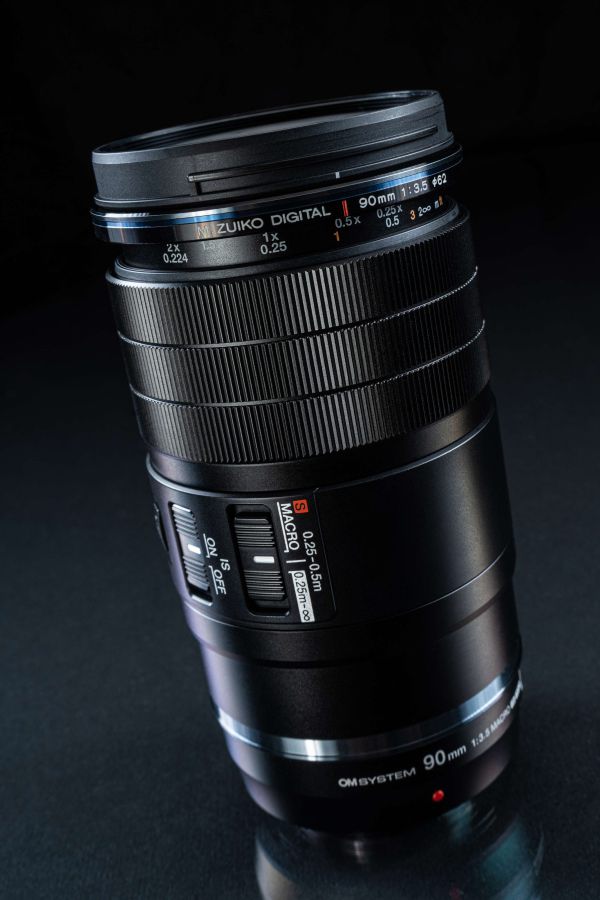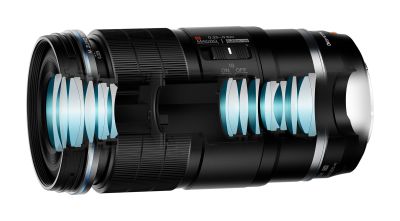M.ZUIKO DIGITAL ED 90mm F3.5 Macro IS PRO

Beschreibung
Am 08.02.2023 stellte OM Digital Solutions ein weiteres Makro-Objektiv vor: Das M.ZUIKO DIGITAL ED 90mm F3.5 Macro IS PRO.
Vergleichbar einem 180 mm-Objektiv im Kleinbildformat ist es ein Vertreter der längeren Tele-Objektive mit (extremer) Makro-Fähigkeit.
Das M.ZUIKO DIGITAL ED 90mm F3.5 Macro IS PRO ist - im Vergeich zu den anderen verfügbaren Makro-Objektiven des mFT-Systems (wie z.B. das M.ZUIKO DIGITAL ED 60mm F2.8 Macro) - relativ groß und schwer.
Bei voller Ausnutzung des Abbildungsmaßstabes 2:1 ist zu beachten, dass die "effektive Blende" (d.h. die Transmission) auf T8.0 sinkt (Quelle).
Die Naheinstellgrenze wird mit 22.4 cm beim Abbildungsmaßstab 2:1 angegeben, der Abbildungsmaßstab kann bei Nutzung des (optionalen) Telekonverters MC-20 auf 4:1 vergrößert werden. Hier ist aber zu beachten, dass die Kombination nur noch eine Lichtstärke von F7.0 hat.
Weiterhin ist zu beachten, dass das M.ZUIKO DIGITAL ED 90mm F3.5 Macro IS PRO - u.a. wg. der langen Brennweite - nur einen sehr kleinen Schärfentiefenbereich besitzt:
- bei F4 und Abbildungsmaßstab 1:1 - wenige 1/100 mm
- bei F5.6 und Abbildungsmaßstab 1:1 - 17/100 mm
Bitte beachten: Bei zu starker Abblendung rediziert sich die Abbildungsleistung (Stichwort: Beugungsunschärfe), das Objektiv ermöglicht aber - bei kompatiblen Kameras - Fokusbracketing und Fokusstacking!
Fasst man die Wertungen der bekannten Quellen zusammen, handet es sich beim M.ZUIKO DIGITAL ED 90mm F3.5 Macro IS PRO um ein mFT-Objektiv für einen "sehr kleinen und speziellen Anwendungsbereich", der Nutzer solle - immer im Einzelfall - entscheiden, ob nicht ein anderes Objektiv für seinen Einsatzbereich besser geeignet sei (z.B. das optisch hervorragende M.ZUIKO DIGITAL ED 60mm F2.8 Macro).
Annähernd vergleichbare Objektive gab es schon der Vergangenheit:
- Sigma 150mm, F2.8 EX DG APO HSM IF Macro - ein FT-Objektiv, welches aber - z.B. mittels des Adapters MMF-1 - an mFT-Kameras adaptiert werden kann
- Canon EF 1:3.5/180 mm L Macro - ein (schon etwas älteres) Objektiv von Canon für das 35-mm-Format
- Tamron 1:3,5/180 mm AF DI - ein (schon etwas älteres) Objektiv von Tamron für das 35-mm-Format
Lt. den bekannten Quellen wurden diese "speziellen" Objektive nur in geringen Stückzahlen vermarktet.
Hauptmerkmale
Hauptmerkmale des Objektives:
- Abbildungsmaßstab 2:1
- kompatibel mit den Telekonvertern:
- Bildstabilisierung:
- Lens IS (d.h. im Objektiv - bis zu 6 Blenden)
- Sync IS (d.h. der eingebaute Bildstabilisator (IS) arbeitet mit dem Bildstabilisator der Olympus-/OM-System-Kamera zusammen - bis zu 7 Blenden)
- Schutzklasse IP53 (Staub-, Spritz-Schutz sowie Frost-Schutz bis -10 °C)
- schmutzabweisende Fluorbeschichtung der Frontlinse
- programmierbarer L-Fn-Funktionsknopf
- schaltbarer Fokusbegrenzer
- Fokus-Clutch
- der Fokusring kann zur linearen manuellen Fokussierung nach hinten (d.h. zum Kamera-Bajonett) gezogen werden
- im Gegensatz zu den anderen bekannten mFT-Objektiven von Olympus/OM-System kann in der Normalstellung des Fokusrings auch manuell fokussiert werden, hierbei erfolgt diese aber dynamisch (d.h. die Drehgeschwindigkeit bestimmt die Geschwindigkeit der Fokussierung)
Vor- und Nachteile
Das Portal lenstip.com nennt folgende Vor- und Nachteile des Objektivs:
- Vorteile
- formschönes, solides und wetterfestes Gehäuse
- sehr gute Bildqualität in der Bildmitte
- gute Bildqualität an den Bildrändern
- leichte Farblängsfehler
- geringe laterale chromatische Aberrationen
- keine Probleme mit sphärischer Aberrationen
- vernachlässigbare Verzeichnung
- sehr gut korrigiertes Koma
- sehr geringer Astigmatismus
- ordentliche Vignettierungskorrektur
- effiziente optische Stabilisierung
- ansprechendes Bokeh im Vor- und Hintergrund
- Nachteile
- schlechte Zusammenarbeit mit dem MC-20-Telekonverter (u.a. "effektive Blende")
- zu geringe Offenblende, die es unmöglich macht, die Möglichkeiten des Systems voll auszuschöpfen.
Zitate
Ein Zitat aus "OM System 90 mm F3,5 Macro IS ED Pro im Test" in digitalkamera.de:
- "Die optische Qualität des OM System 90 mm F3,5 Macro IS ED Pro überzeugt auf ganzer Linie. Die Auflösung ist ab Offenblende hoch und fällt zum Bildrand kaum ab. Zudem sind die optischen Fehler gering und das Bokeh sehr harmonisch. Dank effektivem Bildstabilisator ermuntert es zu qualitativ hochwertigen Makro-Aufnahmen aus freier Hand. Auch am hochwertigen Metallgehäuse samt IP53-Schutz gibt es kaum etwas zu kritisieren. Der Preispunkt von etwa 1.500 Euro ist jedoch für ein Spezialobjektiv, trotz der hohen Bildqualität und der phänomenalen Vergrößerung, sehr steil, zumal ein Einsatz als normales Teleobjektiv für die schnelle Fotografie durch die langsame Fokussierung eher zweifelhaft ist."
Zum Bokeh ein Zitat aus "90er Makro im Gegenlicht." bei pen-and-tell.de:
- "Hatten wir schon lange nicht mehr: eckiges Bokeh. Die Strahlen rechts oben von der Sonne werden mit dem Abblenden immer präsenter. Und ja, das Gras ist unscharf – morgendlicher Wind. Positiv: Das Bokeh ist gleichmäßig, kein ausgeprägtes Cats-Eye-Bokeh, was man in letzter Zeit häufig gesehen hat."
Ein Zitat aus "m.Zuiko 90mm vs Sigma 150mm" bei pen-and-tell.de:
- "In Summe: für Makrofans, die sich um Fluchtdistanzen nichts kümmern müssen, ist das 90er eine feine Sache. Stativ ist Pflicht und bei größeren Abbildungsmaßstäben manueller Fokus. Wer das 60er schon hat und eine gute Vorsatzlinse braucht das 90er nicht."
Einige Zitate aus "OM System M.Zuiko Digital ED 90 mm f/3.5 Macro IS PRO" in lenstip.com:
- "Our resolution test showed clearly that the lens has to be closed down by 1-1.5 EV to reach the peak of its performance. It means that the macro scale and the maximum performance needs an effective aperture f/8-11 so you will have to tolerate just decent resolution values near 55-65 lpmm at most. They are very far from record values amounting to 95-100 lpmm that are possible to achieve in the Micro 4/3 system."
"Another misconception is a recommendation for photographers to attach the OM System M.Zuiko Digital ED 90 mm f/3.5 Macro IS PRO to a teleconverter. We are tempted by an impressive 4:1 mapping scale but nobody mentions the fact that working in its proximity you can count on the maximum effective aperture of f/16. By f/16 the Micro 4/3 system is simply useless because it provides resolution on a level of just 40-42 lpmm. Indeed, even such values are unattainable because it's a diffraction limit for this aperture. Meanwhile for this set it constitutes the maximum relative aperture which has to be closed down by 1-3 EV in order to achieve the peak of the performance. It means in turn you would have to employ f/22-45 apertures which are completely useless in the case of the Micro 4/3 system."
Hier einige kurze Zitate aus "OM SYSTEM M.Zuiko ED 90mm f/3.5 Macro IS PRO" von Ken Rockwell":
- "Obviously its optics are superb as we expect in every macro lens."...."This lens stands out for its world's greatest 2:1 (2× lifesize) repro ratio in an autofocus lens, exceptional freedom from Distortion, great Ergonomics, no visible Falloff and marvelous Stabilization."...."2× Life Size (180mm 4× eq.), Today's Best Macro Lens"
Ein Zitat aus "OM System 90mm f/3.5 Macro IS PRO" in photographylife.com:
- "In short, the OM System 90mm f/3.5 Macro IS PRO is an exceptionally sharp, high-performing macro lens with great usability due to the large working distance. Once you adapt to the peculiarities of focusing with this lens, it’s hard to beat – and I’d say it’s stolen the crown as the ultimate macro lens for the Micro Four Thirds system."
Ein Zitat aus "The Most Amazing Macro With a Catch: OM System 90mm F3.5 Macro IS Pro Review" in thephoblographer.com:
- "Yes, the OM System 90mm f3.5 Macro IS Pro is impressive indeed. But, there is a catch — the f3.5 aperture isn’t available in Super Macro. Considering the tiny sliver of focus that a 4x macro, 180mm equivalent lens has though, many photographers are going to want to stop down the aperture further. Formally called the M. Zuiko Digital ED 90mm f3.5 Macro IS Pro, the lens does what few others can do. While 5x macro full-frame lenses exist, few lenses past the 1:1 ratio are still equipped with autofocus, making the 90mm f3.5 Macro stand out."
Ein Zitat aus "OM System 90mm f/3.5 Macro IS PRO" in photographylife.com:
- "In short, the OM System 90mm f/3.5 Macro IS PRO is an exceptionally sharp, high-performing macro lens with great usability due to the large working distance. Once you adapt to the peculiarities of focusing with this lens, it’s hard to beat – and I’d say it’s stolen the crown as the ultimate macro lens for the Micro Four Thirds system."
Trivia
Schon vor mehr als 15 Jahren war ein 100-mm-Tele-Makro auf der FT-Roadmap zu finden. Es sollte 2008 auf den Markt kommen, später wurde es auf "nach 2009" verschoben - es erlangte aber nie die Marktreife. (Unbestätigten) Gerüchten nach war einer der Gründe die Vorstellung des 150mm-F2.8-Makro-Objektiv von Sigma.
Technische Daten
| Hersteller: | OM System | Bezeichnung: | M.ZUIKO DIGITAL ED 90mm F3.5 Macro IS PRO | |||||||||
|---|---|---|---|---|---|---|---|---|---|---|---|---|
| Brennweite: | 90 mm | Herstellungszeitraum: | 2023 - - | |||||||||
| Lichtstärke: | 3.5 | Blendenbereich: | 3.5-22 | |||||||||
| Baulänge: | 136 mm | Durchmesser: | 69.8 mm | |||||||||
| Gewicht: | 453 g | Filtergewinde: | 62 mm | |||||||||
| Min. Entfernung: | 22.4 cm | Max. Abbildungsm.: | 2.0 x (Micro FT) / 4.0 x (35-mm-Format) | |||||||||
| Bajonett: | Micro FT | Spritz-/Staubschutz: | ja | Bildstabilisator: | ja | |||||||
| Bildwinkel: | 14° | Linsen/Baugruppen: | 18/13 | Blendenaufbau: | 7 kreisförmige Lamellen | |||||||
| Innenfokussierung: | ja | Geradführung: | ja | Innenzoom: | entfällt | |||||||
| AF-Antrieb: | MSC | Fokussierung: | by Wire | Zoom: | entfällt | |||||||
| Besonderheiten: | volle Kontrast-AF-Funktionsunterstützung, 2 Super ED lenses, 4 ED lenses, 1 Super HR lens, 1 HR lens, kompatibel mit den Konvertern MC-14 und MC-20 | |||||||||||
Lieferumfang
- M.ZUIKO DIGITAL ED 90mm F3.5 Macro IS PRO (schwarz)
- Streulichtblende (LH-66E)
- Micro Four Thirds Objektivdeckel (LC-62G)
- Hintere Objektivkappe für Micro Four Thirds Objektive (LR-2)
- Garantieunterlagen und Bedienungsanleitung
Optional
- Schutzfilter PRF-ZD62 PRO
- Objektivköcher LSC-0914
Galerie

M.ZUIKO DIGITAL ED 90mm F3.5 Macro IS PRO an einer OM-1 - mit freundlicher Genehmigung von OM Digital Solutions
M.ZUIKO DIGITAL ED 90mm F3.5 Macro IS PRO an einer OM-1 - mit freundlicher Genehmigung von OM Digital Solutions
M.ZUIKO DIGITAL ED 90mm F3.5 Macro IS PRO - mit freundlicher Genehmigung von OM Digital Solutions
M.ZUIKO DIGITAL ED 90mm F3.5 Macro IS PRO - mit freundlicher Genehmigung von OM Digital Solutions
M.ZUIKO DIGITAL ED 90mm F3.5 Macro IS PRO - mit freundlicher Genehmigung von OM Digital Solutions
M.ZUIKO DIGITAL ED 90mm F3.5 Macro IS PRO - mit freundlicher Genehmigung von OM Digital Solutions
M.ZUIKO DIGITAL ED 90mm F3.5 Macro IS PRO - mit freundlicher Genehmigung von OM Digital Solutions
"Zangenblitz" STF-8 mit der M.ZUIKO DIGITAL ED 90mm F3.5 Macro IS PRO (an einer OM-1) - mit freundlicher Genehmigung von OM Digital Solutions
Linsenschnitt des M.ZUIKO DIGITAL ED 90mm F3.5 Macro IS PRO - mit freundlicher Genehmigung von OM Digital Solutions
Dichtungen des M.ZUIKO DIGITAL ED 90mm F3.5 Macro IS PRO - mit freundlicher Genehmigung von OM Digital Solutions
IS-Fuktionen des M.ZUIKO DIGITAL ED 90mm F3.5 Macro IS PRO - mit freundlicher Genehmigung von OM Digital Solutions
Tests und Bewertungen
Weblinks
- Ankündigung auf digitalkamera.de
- "OM System 90 mm F3,5 Macro IS ED Pro im Test" in digitalkamera.de (lesenswert)
- "Weitere Details zum OM System 90 mm F3,5 Macro IS ED Pro" in digitalkamera.de
- "90er Makro im Gegenlicht." bei pen-and-tell.de
- "Früher war alles besser… Sigma 150mm f/2,8" bei pen-and-tell.de
- "m.Zuiko 90mm vs Sigma 150mm" bei pen-and-tell.de
- "OM System M.Zuiko Digital ED 90 mm f/3.5 Macro IS PRO" in lenstip.com (englisch - lesenswert)
- "OM SYSTEM M.Zuiko ED 90mm f/3.5 Macro IS PRO" von Ken Rockwell" (englisch)
- "OM System 90mm f/3.5 Macro IS PRO" in photographylife.com (englisch)
- "The Most Amazing Macro With a Catch: OM System 90mm F3.5 Macro IS Pro Review" in thephoblographer.com (englisch)
- "OM System 90mm f/3.5 Macro IS PRO" in photographylife.com (englisch)
Beispielaufnahmen
Bitte beachten:
Die tatsächliche Darstellung von Bokeh, Schärfe, Kontrast, Schärfentiefe etc. treten erst bei der Betrachtung in "Vollauflösung" in Erscheinung, hierzu wurden viele Bildbeispiele in Originalgröße (aber stark komprimiert) hinterlegt.











